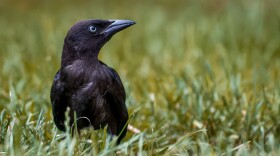-
On this lazy Sunday just outside Missoula, I can hear only two cranes from the former flock. Perhaps these are the late sleepers, the teenagers, left by the wayside as the larger family group launched back to the migratory grind and headed north to their breeding grounds. Spring is the season of courtship, and what I’m listening to may well be the first pairing of lovers who will mate for life.
-
I’ll never forget the first time I heard the call of a Sandhill Crane. It was early June, and I was halfway through an eight-day backpacking trip in the Sapphire Mountains. Sitting in a meadow one evening and refilling my bottle at the oxbow of a quiet creek, I began to hear a sound unlike anything I’d ever heard. It was part elephant, part jackhammer, and part squeaky door hinge. One thing seemed clear: no way had that sound been made by a modern animal, and certainly not by a bird.
-
One June about seven years ago, my husband brought home a bitterroot plant. It was stuck to his irrigation shovel by the clay soil from the hay fields near our house in the Helmville Valley. I marveled at the beautiful hot pink blooms and planted them in the flower bed, where they rarely reappeared.
-
Early in April, I had just spied a fox squirrel eating pine seeds from a ground cache when I felt a shadow gliding overhead on silent wings. I looked up yet saw nothing. When I looked back, there was an indistinct gray form, an apparition, in the shadows where the squirrel had been. The apparition turned its head toward me and peered with two large golden eyes. Tufted horns now held erect confirmed it was a Great Horned Owl.
-
What do tree swallows, starlings, pigeons, hummingbirds, and mallard ducks all have in common? Besides being birds, of course, each of these species sports iridescent feathers that glimmer and shine when the light hits them.
-
As spring rains tame the dust of the Montana plains and rinse the grasses briefly to green, spadefoot toads (Spea bombifrons) will stir for the first time in a year and clamber from burrows beneath the soil’s frostline to the surface. There they will congregate in pools of snowmelt and rainwater, and they will sing.
-
After several long moments the bird erupted out of the water, landing on its stone while droplets rolled off its tightly woven feathers, a look of nonchalance twinkling in its chocolate-brown eye. I blinked. A diving songbird? I thought I knew water birds: ducks, ospreys, bald eagles, kingfishers. But here was a robin-sized bird using river stones as diving boards, doing who knows what in currents too strong for me to cross.
-
One warm, sunny day I saw a crow squatting low on a large ant hill, head high, wingtips outstretched and fluttering softly on the ground. I had never seen this behavior before and I wondered if she might be injured. I watched her with concern before she stood up, briefly picked at her feathers, and flew away.
-
One afternoon while balcony-bird-watching, my attention was captured by a tiny black speck aggressively pursuing much larger birds, undeterred by the threat of sharp beaks and deadly talons. With equal measure, he intimidated crows, Osprey, eagles, vultures, and herons away from his territorial claim along the riverbank. With my binoculars and guidebook in hand, I identified him as a male Red-winged Blackbird after he flashed the telltale red and yellow striped epaulets on his shoulders, and loudly sang, “CONK-LA-REEEEE!” when he settled on a shoreline tree branch.
-
Many little creatures are decomposers and their lives depend on the death of others; such is the cycle of life. Recycling in its truest form!
Play Live Radio
Next Up:
0:00
0:00
Available On Air Stations










